Higher classification Cedar | Division Pinophyta Scientific name Cedrus libani Rank Species | |
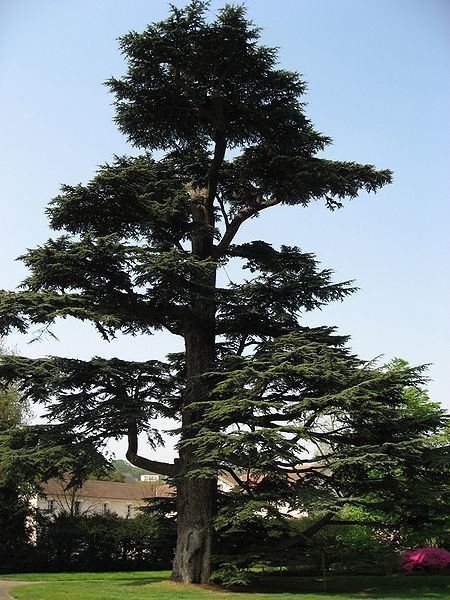 | ||
Similar Cedar, Cedrus atlantica, Deodar cedar, Conifers, Pinus nigra | ||
Cedrus libani, commonly known as the Cedar of Lebanon is a species of cedar native to the mountains of the Eastern Mediterranean basin. It is an evergreen conifer that can reach 40 m in height. Cedrus libani is the national emblem of Lebanon and is widely used as an ornamental tree in parks and gardens.
Contents
- Description
- Taxonomy
- Distribution and habitat
- History and symbolism
- National and regional significance
- Horticultural use
- Other uses
- Ecology and conservation
- Diseases and pests
- References
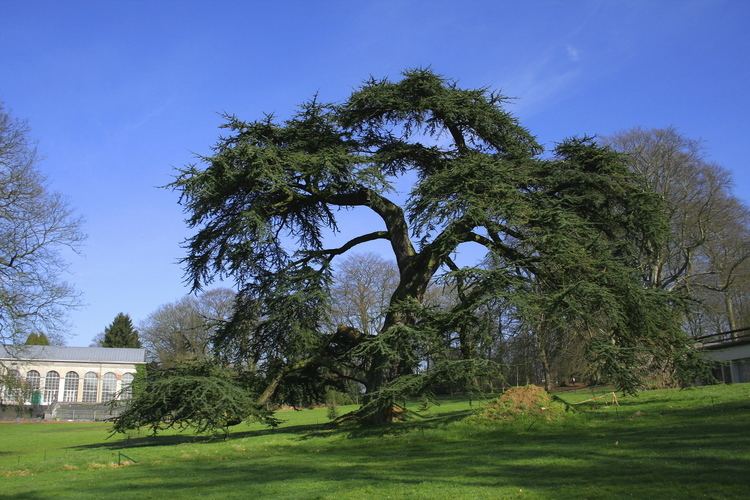
Description
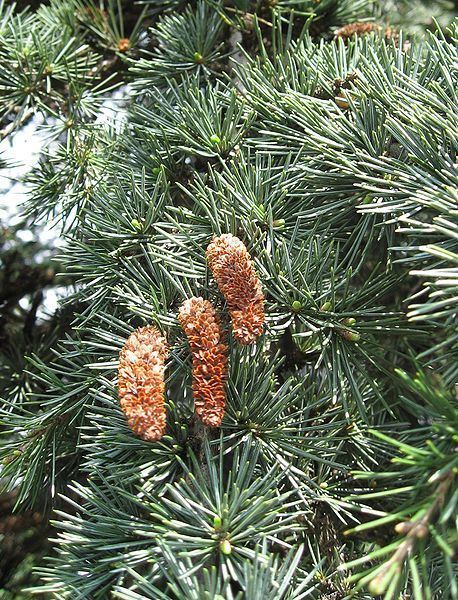
Cedrus libani is an evergreen coniferous tree, it can reach 40 m (130 ft) in height with a massive monopodial columnar trunk up to 2.5 m (8 ft 2 in) in diameter. The trunks of old trees ordinarily fork into several large, erect branches. The rough and scaly bark is dark grey to blackish brown, it is run through by deep horizontal fissures that peel in small chips. The first-order branches are ascending in young trees; they grow to a massive size and take on a horizontal, wide-spreading disposition. Second-order branches are dense and grow in a horizontal plane. The crown is conical when young, becoming broadly tabular with age with fairly level branches; trees growing in dense forests maintain a more pyramidal shape. The shoots are dimorphic, with both long and short shoots. New shoots are pale brown, older shoots turn grey, grooved and scaly. C. libani has slightly resinous ovoid vegetative buds measuring 2 to 3 mm (0.079 to 0.118 in) long and 1.5 to 2 mm (0.059 to 0.079 in) wide enclosed by pale brown deciduous scales. The leaves are needle-like, arranged in spirals and concentrated at the proximal end of the long shoots, and in clusters of 15-35 on the short shoots; they are 5 to 35 mm (0.20 to 1.38 in) long and 1 to 1.5 mm (0.039 to 0.059 in) wide, rhombic in cross-section, and vary from light green to glaucous green with stomatal bands on all four sides. Cedrus libani produces cones at around the age of 40; it flowers in autumn, the male cones appear in early September and the female ones in late September. Male cones occur at the ends of the short shoots; they are solitary and erect approximately 4 to 5 cm (1.6 to 2.0 in) long and mature from a pale green to a pale brown color. The female seed cones also grow at the terminal ends of short shoots. The young seed cones are resinous, sessile and pale green; they require 17 to 18 months after pollination to mature. The mature woody cones are 8 to 12 cm (3.1 to 4.7 in) long and 3 to 6 cm (1.2 to 2.4 in) wide; they are scaly, resinous, ovoid or barrel shaped and gray-brown in color. Mature cones open from top to bottom, they disintegrate and lose their seed scales releasing the seeds until only the cone rachis remains attached to the branches. The seed scales are thin, broad and coriaceous measuring 3.5 to 4 cm (1.4 to 1.6 in) long and 3 to 3.5 cm (1.2 to 1.4 in) wide. The seeds are ovoid, 10 to 14 mm (0.39 to 0.55 in) long and 4 to 6 mm (0.16 to 0.24 in) wide, attached to a light brown wedge-shaped wing that's 20 to 30 mm (0.79 to 1.18 in) long and 15 to 18 mm (0.59 to 0.71 in) wide. Cedrus libani grows rapidly until the age of 45 to 50 years; growth becomes extremely slow after the age of 70 years.
Taxonomy
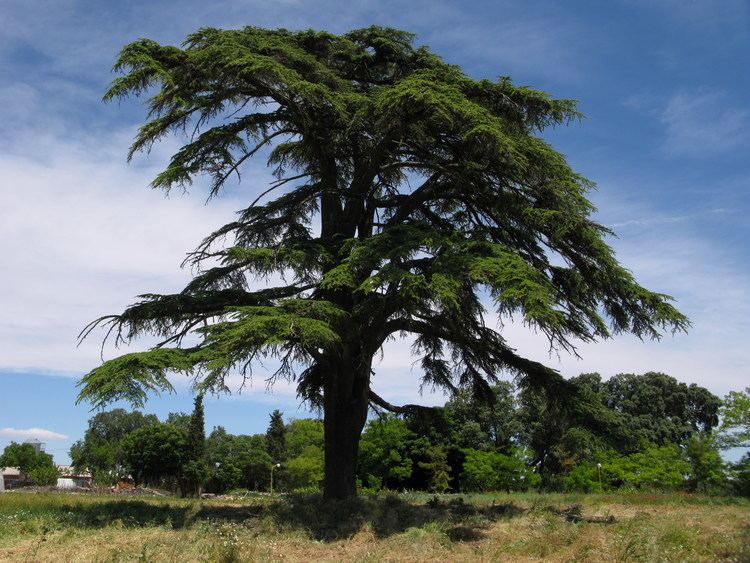
Cedrus is the Latin name for true cedars. The specific epithet refers the Lebanon mountain range where the species was first described by French botanist Achille Richard; the tree is commonly known as the Lebanon cedar or Cedar of Lebanon. There are two distinct types that are recognized as varieties: C. libani var. libani and C. libani var. brevifolia.
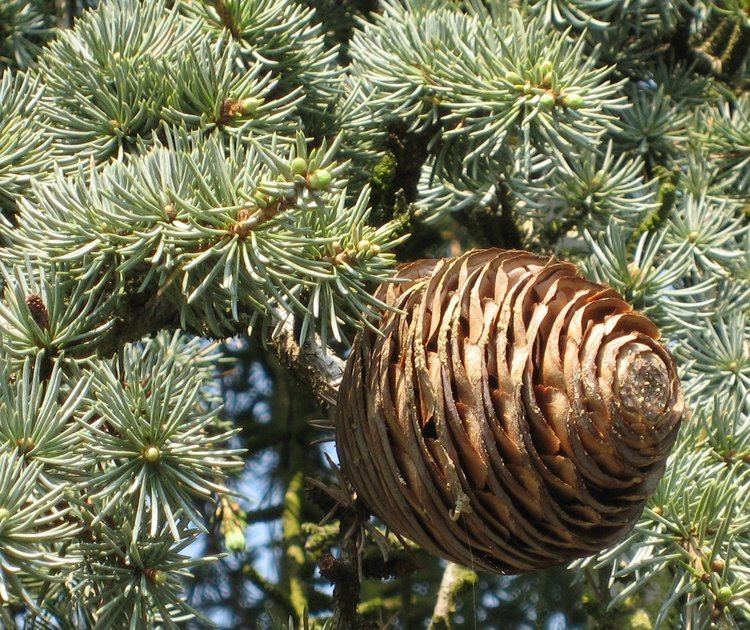
C. libani var. libani: Lebanon cedar, cedar of Lebanon – grows in Lebanon, western Syria, and south central Turkey. C. libani var. stenocoma (the Taurus cedar) considered a subspecies in earlier literature, is now recognized as an ecotype of C. libani var. libani. It usually has a spreading crown that doesn't flatten. This distinct morphology is a habit that's assumed to cope with the competitive environment since the tree occurs in dense stands mixed with the tall-growing Abies cilicica, or in pure stands of young cedar trees.
C. libani var. brevifolia: The Cyprus cedar occurs on the island's Troodos Mountains. This taxon was considered a separate species from C.libani because of morphological and ecophysiological tratit differences. It is characterized by slow growth, shorter needles and higher tolerance to drought and aphids. Genetic relationship studies however did not recognize C. brevifolia as a separate species, the markers being undistinguishable from those of C. libani.
Distribution and habitat
Cedrus libani var. libani is endemic to elevated mountains around the Eastern Mediterranean in Lebanon, Syria, and Turkey. The tree grows in well-drained calcareous lithosols on rocky, North and west-facing slopes and ridges and thrives in rich loam or a sandy clay in full sun. Its natural habitat is characterized by warm, dry summers and cool, moist winters with an annual precipitation of 1,000 to 1,500 mm (39 to 59 in); the trees get are blanketed by a heavy snow cover at the higher altitudes. In Lebanon and Turkey it occurs most abundantly at altitudes of 1,300 to 3,000 m (4,300 to 9,800 ft), where it forms pure forests or mixed forests with Cilician fir (Abies cilicica), European black pine (Pinus nigra), East Mediterranean pine (Pinus brutia) and several juniper species. In Turkey it can occur as low as 500 m (1,600 ft).
Cedrus libani var. brevifolia grows in similar conditions on medium to high mountains in Cyprus from altitudes ranging from 900 to 1,525 m (2,953 to 5,003 ft).
History and symbolism
The Lebanon Cedar is mentioned several times in the Old Testament. Hebrew priests were ordered by Moses to use the bark of the Lebanon cedar in the treatment of leprosy. Solomon also procured cedar timber to build the Temple in Jerusalem. The Hebrew prophet Isaiah used the Lebanon cedar as a metaphor for the pride of the world, with the tree explicitly mentioned near the end of Psalm 92 as a symbol of the righteous.
National and regional significance
The Lebanon cedar is the national emblem of Lebanon, and is displayed on the flag of Lebanon and coat of arms of Lebanon. It is also the logo of Middle East Airlines (MEA), which is Lebanon's national carrier. Beyond that, it is also the main symbol of Lebanon's "Cedar Revolution" of 2005, along with many Lebanese political parties and movements, such as the Kataeb Party, the Lebanese Forces, the National Liberal Party, and the Future Movement. Finally, Lebanon is sometimes metonymically referred to as the Land of the Cedars.
Horticultural use
The Lebanon cedar is widely planted as an ornamental tree in parks and gardens.
It is unknown when the first cedar of Lebanon was planted in Britain, but it dates at least to 1664, when it is mentioned in Sylva, or A Discourse of Forest-Trees and the Propagation of Timber. In Britain, cedars of Lebanon are known for their use in London's Highgate Cemetery.
C. libani has gained the Royal Horticultural Society's Award of Garden Merit.
Other uses
Cedar wood is very prized for its fine grain, attractive yellow color and fragrance. It is exceptionally durable and immune to insect ravages. Wood from C. libani has a density of 560 kg/m³; it is used for furniture, construction and handicrafts. In Turkey, shelterwood cutting and clearcutting techniques are used to harvest timber and promote uniform forest regeneration. Cedar resin (cedria) and cedar essential oil (cedrum) are prized extracts from the timber and cones of the cedar tree.
Ecology and conservation
Historically, there were various attempts at conserving the Lebanon cedars. The first was made by the Roman emperor Hadrian; he created an imperial forest and ordered it marked by inscribed boundary stones, two of which are in the museum of the American University of Beirut.
Over the centuries, extensive deforestation has occurred, with only small remnants of the original forests surviving. Deforestation has been particularly severe in Lebanon and on Cyprus; on Cyprus, only small trees up to 25 m (82 ft) tall survive, though Pliny the Elder recorded cedars 40 m (130 ft) tall there. Extensive reforestation of cedar is carried out in the Mediterranean region. in Turkey, over 50 million young cedars are planted annually; covering an area of approximately 300 square kilometres (74,000 acres). Lebanese cedar populations are also expanding through an active program combining replanting and protection of natural regeneration from browsing goats, hunting, forest fires, and woodworms. The Lebanese approach emphasizes natural regeneration by creating proper growing conditions. The Lebanese state has created several reserves including the Chouf Cedar Reserve, the Jaj Cedar Reserve, the Tannourine Reserve, the Ammouaa and Karm Shbat Reserves in the Akkar district, and the Forest of the Cedars of God near Bsharri.
Diseases and pests
C. libani is susceptible to a number of soil-borne, foliar and stem pathogens. The seedlings are prone to fungal attacks. Botrytis cinerea, a necrotrophic fungus that is known to cause considerable damage to food crops, attacks the cedar needles causing them to turn yellow and drop. Armillaria mellea (commonly known as honey fungus) is a basidiomycete that fruits in dense clusters at the base of trunks or stumps and attacks the roots of cedars growing in wet soils. The Lebanese cedar shoot moth (Parasyndemis cedricola) is a species of moth of the family Tortricidae found in the forests of Lebanon and Turkey; its larvae feed on young cedar leaves and buds.
